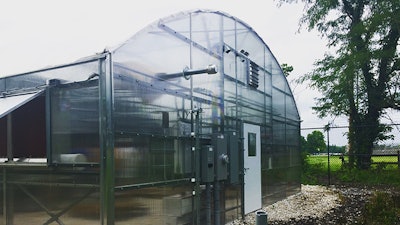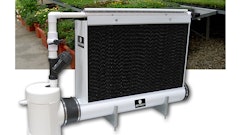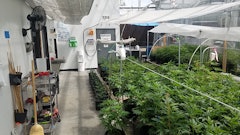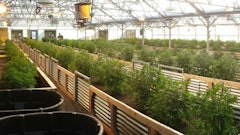
Before designing an HVAC and ventilation plan for a greenhouse, it’s important to know what exactly the structure will need. Ben George, western school sales associate for International Greenhouse Company, talked with Cannabis Business Times about how to determine the proper specs for a system.
Kyle Brown: How do you determine what you’ll need for a greenhouse?
Ben George: The most important thing to understand is its location, when it comes to what kind of HVAC setup or airflow setup they’ll need. There are some things that are standard, and some that will vary a little bit. For instance, in California, in areas of lower humidity the needs may be different than areas of higher humidity.
In Colorado, you’re at a higher elevation, so the air is a little thinner, so you have to take that into account when you’re sizing equipment. The general rule of thumb in the greenhouse industry is that because of the solar gain, we have to move air rapidly through the building so it doesn’t heat up too much.
Greenhouses are designed to get hot, right? And the problem is that when you’re trying to cool it, you have to have a high air exchange. The most important thing that we start with is the total volume of air in the greenhouse. We want to try to exchange that one per minute. So we help [growers] with the calculation of the cubic volume of air in the greenhouse.
Let’s say the cubic volume of air is 20,000 cubic feet in a greenhouse. All the exhaust fans and even the circulation fans have a CFM or “cubic feet per minute” rating. So if it’s 20,000 cubic feet, of air inside the structure, we would find exhaust fans that move at least that per minute. It may mean we need two 36-inch exhaust fans that are rated at 10,800 cubic feet per minute. Those two are going to help us change that air.
On the opposite end of the structure, we need air intake, and that’s also important to be sized appropriately. One issue some people have, especially in light deprivation greenhouses, is that in an effort to block out light, they’ll use steel on the end walls; they’ll have light deprivation curtain systems. People are starting to put light traps built in as part of the exhaust fans. One of the issues with that is that light traps do restrict air. You’re constricting the air, and by doing that, you’re putting more static pressure on the motor … which can have it burn out in a year. [This is] the reason why it’s important to have your exhaust fan manufacturer also design the light trap housing.
Brown: What’s something you wish more growers understood about proper air flow?
George: Probably just the … instability of growing in a greenhouse compared [to indoor grows]. That’s the biggest issue we run into with the cannabis industry. It’s the only agricultural industry that has its roots and origins indoors.
When you’re indoors you can control everything. Every factor can be controlled very, very easily. You can control temperature and humidity very well.
Every farmer out there understands how nature is different every day. There’s variables that get thrown to you, and the expectation with a lot of growers when it’s their first greenhouse is … they don’t understand they’re going to have to deal with a lot more variables moving to a greenhouse grow situation.
Many people use greenhouses to create a tropical environment. It’s going to breed humidity and things like that. They sometimes don’t take into account that every day the weather is going to be different, or cloud cover could be different.
It’s tough for a lot of growers who have tons of knowledge. They’ve been growing indoors for years and years. But they have to change their strategy a bit when they go into a greenhouse grow.
Brown: What’s your advice to growers struggling with that?
George: I think what’s important is to set the expectations from the beginning and be honest with some of the complications they can run into. But then also, to have the knowledge to help them, and give them information to plan for these issues.
For instance, humidity control: What’s more important to you? Maintaining 30 percent humidity levels with the temperature at 100 degrees, or having 65 to 70 percent humidity levels and the temperature at 90 degrees? So I think education of those differences [is important] … and understanding what people want. Are they looking at the greenhouse as a seasonal grow or year-round? Are they trying to get four or five cycles out of the greenhouse? Well, then we need to design it a little bit differently, especially in the ventilation, the heating and overall HVAC, we have to be able to design it to be effective.
Kyle Brown: How do you determine what you’ll need for a greenhouse?
Ben George: The most important thing to understand is its location, when it comes to what kind of HVAC setup or airflow setup they’ll need. There are some things that are standard, and some that will vary a little bit. For instance, in California, in areas of lower humidity the needs may be different than areas of higher humidity.
In Colorado, you’re at a higher elevation, so the air is a little thinner, so you have to take that into account when you’re sizing equipment. The general rule of thumb in the greenhouse industry is that because of the solar gain, we have to move air rapidly through the building so it doesn’t heat up too much.
Greenhouses are designed to get hot, right? And the problem is that when you’re trying to cool it, you have to have a high air exchange. The most important thing that we start with is the total volume of air in the greenhouse. We want to try to exchange that one per minute. So we help [growers] with the calculation of the cubic volume of air in the greenhouse.
Let’s say the cubic volume of air is 20,000 cubic feet in a greenhouse. All the exhaust fans and even the circulation fans have a CFM or “cubic feet per minute” rating. So if it’s 20,000 cubic feet, of air inside the structure, we would find exhaust fans that move at least that per minute. It may mean we need two 36-inch exhaust fans that are rated at 10,800 cubic feet per minute. Those two are going to help us change that air.
On the opposite end of the structure, we need air intake, and that’s also important to be sized appropriately. One issue some people have, especially in light deprivation greenhouses, is that in an effort to block out light, they’ll use steel on the end walls; they’ll have light deprivation curtain systems. People are starting to put light traps built in as part of the exhaust fans. One of the issues with that is that light traps do restrict air. You’re constricting the air, and by doing that, you’re putting more static pressure on the motor … which can have it burn out in a year. [This is] the reason why it’s important to have your exhaust fan manufacturer also design the light trap housing.
Brown: What’s something you wish more growers understood about proper air flow?
George: Probably just the … instability of growing in a greenhouse compared [to indoor grows]. That’s the biggest issue we run into with the cannabis industry. It’s the only agricultural industry that has its roots and origins indoors.
When you’re indoors you can control everything. Every factor can be controlled very, very easily. You can control temperature and humidity very well.
Every farmer out there understands how nature is different every day. There’s variables that get thrown to you, and the expectation with a lot of growers when it’s their first greenhouse is … they don’t understand they’re going to have to deal with a lot more variables moving to a greenhouse grow situation.
Many people use greenhouses to create a tropical environment. It’s going to breed humidity and things like that. They sometimes don’t take into account that every day the weather is going to be different, or cloud cover could be different.
It’s tough for a lot of growers who have tons of knowledge. They’ve been growing indoors for years and years. But they have to change their strategy a bit when they go into a greenhouse grow.
Brown: What’s your advice to growers struggling with that?
George: I think what’s important is to set the expectations from the beginning and be honest with some of the complications they can run into. But then also, to have the knowledge to help them, and give them information to plan for these issues.
For instance, humidity control: What’s more important to you? Maintaining 30 percent humidity levels with the temperature at 100 degrees, or having 65 to 70 percent humidity levels and the temperature at 90 degrees? So I think education of those differences [is important] … and understanding what people want. Are they looking at the greenhouse as a seasonal grow or year-round? Are they trying to get four or five cycles out of the greenhouse? Well, then we need to design it a little bit differently, especially in the ventilation, the heating and overall HVAC, we have to be able to design it to be effective.














